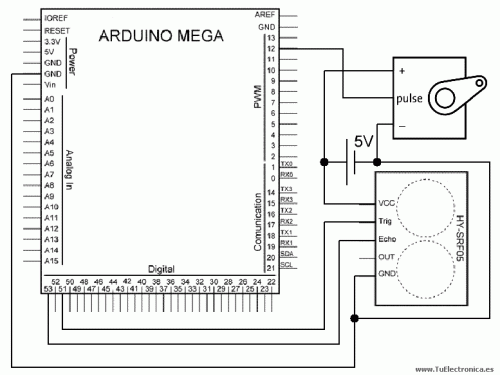
/*
Autor :Jose Pedro R. A. Ribeiro
Data :27/05/2016
Arduino versão 1.6.7
*/
#include <Servo.h> //
Servo leftRightServo; //
int leftRightPos = 0; //
int index = 0; //
long total = 0; //
int average = 0; //
long duration = 0; //
int distance = 0;
// CONFIGURACIÓN:
int echoPin = 53; //
int trigPin = 51; //
int servoPin = 12; //
int servoMin = 700; //
int servoMax = 2400; //
const int numReadings = 2; //
void setup() {
leftRightServo.attach(servoPin,700,2400); //
Serial.begin(9600); //
pinMode(trigPin, OUTPUT); //
pinMode(echoPin, INPUT); //
digitalWrite(trigPin, LOW); //
}
void loop() {
for(leftRightPos = 0; leftRightPos < 180; leftRightPos++) { //
leftRightServo.write(leftRightPos);
for (index = 0; index<numReadings; index++) { //
//
digitalWrite(trigPin, HIGH);
delayMicroseconds(10);
digitalWrite(trigPin, LOW);
duration = pulseIn(echoPin, HIGH, 17400); //
if (!duration){ //
duration = 17400; //
}
distance = duration/58; //
total = total + distance; //
delay(50); //
}
average = total/numReadings; //
total = 0; //
//
Serial.print("X"); //
Serial.print(leftRightPos); //
Serial.print("V"); //
Serial.println(average); //
}
for(leftRightPos = 180; leftRightPos > 0; leftRightPos--) { //
leftRightServo.write(leftRightPos);
for (index = 0; index<numReadings; index++) {
// Pulso de 10us para inicial el modulo
digitalWrite(trigPin, HIGH);
delayMicroseconds(10);
digitalWrite(trigPin, LOW);
duration = pulseIn(echoPin, HIGH, 17400);
if (!duration){
duration = 17400;
}
distance = duration/58;
total = total + distance;
delay(50);
}
average = total/numReadings;
total = 0;
Serial.print("X");
Serial.print(leftRightPos);
Serial.print("V");
Serial.println(average);
}
/*
Autor: Jose Pedro R. A. Ribeiro
Radar Ultrasonico
Processing 3.1.1
Data 27/05/2016 .
*/
import processing.serial.*; //
Serial myPort; //
float x, y; //
int radius = 350; //
int w = 300; //
int degree = 0; //
int value = 0; //
int motion = 0; //
int[] newValue = new int[181]; //
int[] oldValue = new int[181]; //
PFont myFont; //
int radarDist = 0; //
int firstRun = 0; //
int lf = 10; //
void setup(){
size(750, 450); //
background (0); //
myFont = createFont("verdana", 12); //
textFont(myFont); //
println(Serial.list()); //
myPort = new Serial(this,"com7", 9600); //
myPort.bufferUntil(lf); //
}
/* draw the screen */
void draw(){
fill(0); //
noStroke(); //
ellipse(radius, radius, 750, 750); //
rectMode(CENTER); //
rect(350,402,800,100); //
if (degree >= 179) { //
motion = 1; //
}
if (degree <= 1) { //
motion = 0; //
}
/* setup the radar sweep */
/*
We use trigonmetry to create points around a circle.
So the radius plus the cosine of the servo position converted to radians
Since radians 0 start at 90 degrees we add 180 to make it start from the left
Adding +1 (i) each time through the loops to move 1 degree matching the one degree of servo movement
cos is for the x left to right value and sin calculates the y value
since its a circle we plot our lines and vertices around the start point for everything will always be the center.
*/
strokeWeight(7); // set the thickness of the lines
if (motion == 0) { // if going left to right
for (int i = 0; i <= 20; i++) { // draw 20 lines with fading colour each 1 degree further round than the last
stroke(0, (10*i), 0); // set the stroke colour (Red, Green, Blue) base it on the the value of i
line(radius, radius, radius + cos(radians(degree+(180+i)))*w, radius + sin(radians(degree+(180+i)))*w); // line(start x, start y, end x, end y)
}
} else { // if going right to left
for (int i = 20; i >= 0; i--) { // draw 20 lines with fading colour
stroke(0,200-(10*i), 0); // using standard RGB values, each between 0 and 255
line(radius, radius, radius + cos(radians(degree+(180+i)))*w, radius + sin(radians(degree+(180+i)))*w);
}
}
/* Setup the shapes made from the sensor values */
noStroke(); // no outline
/* first sweep */
fill(0,50,0); // set the fill colour of the shape (Red, Green, Blue)
beginShape(); // start drawing shape
for (int i = 0; i < 180; i++)...
Read more » Jose Pedro R. A. Ribeiro
Jose Pedro R. A. Ribeiro

As pessoas pode tambem aprender português
termos técnicos são de fácil compreensão.
vou refletir sobre sugestão .